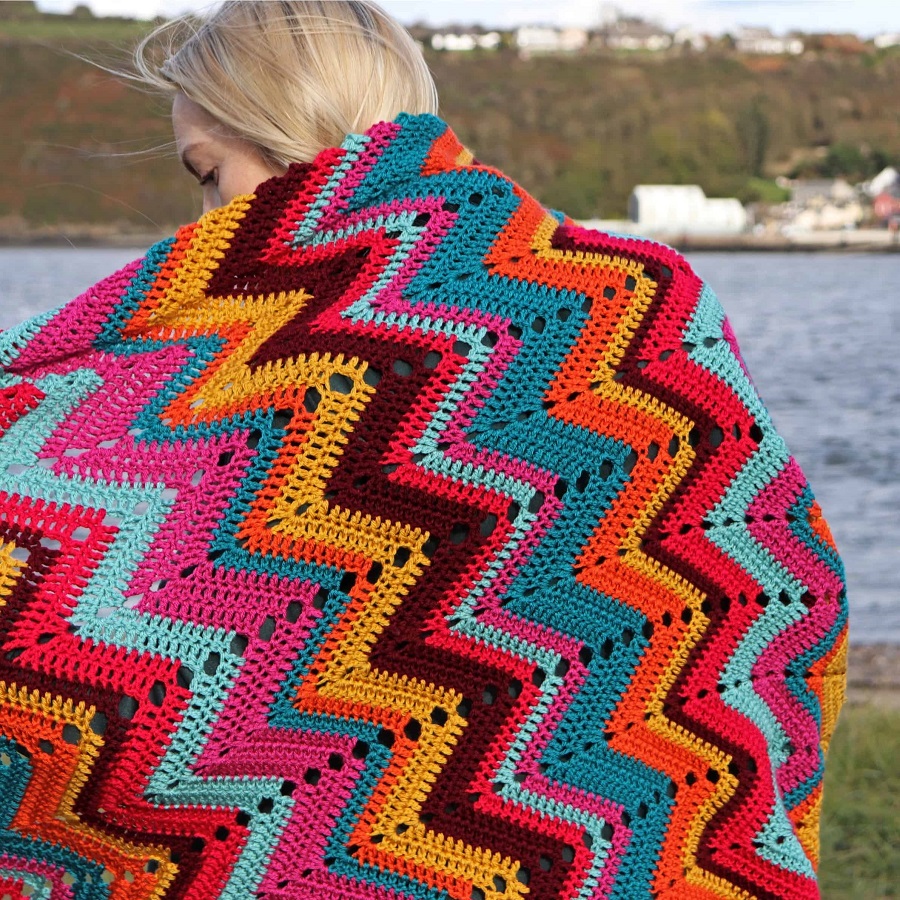Essential Tools and Materials for Crochet Blankets
To start crocheting a blanket, having the right tools and materials is crucial. They ensure your project goes smoothly and results in a comfortable, durable finished product. Let’s delve into selecting the proper yarn and crochet hook for your first blanket project.
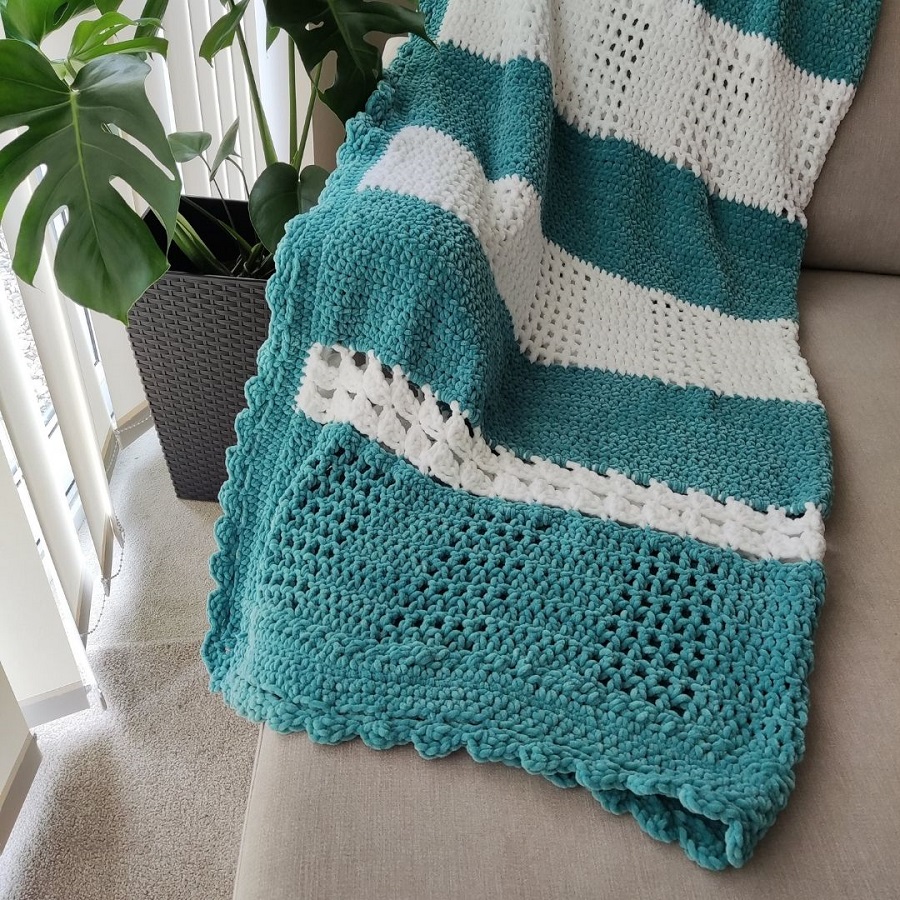
Choosing the Right Yarn
Yarn choice can impact a blanket’s texture, warmth, and overall look. For airy summer blankets, choose DK weight yarn in cotton or linen. These yarns create a lightweight and breathable fabric suitable for warmer climates. In contrast, winter blankets benefit from thicker yarns like worsted weight or chunky. Wool, acrylic, or chenille are excellent options for cozy, warm blankets. Remember to consider the blanket’s purpose and your desired texture when picking your yarn.
Selecting the Perfect Crochet Hook
The crochet hook is just as important as the yarn. A large hook paired with bulky yarn works well for thick blankets. Conversely, a smaller hook is right for lighter yarns. Beginners often find aluminum hooks around the size of 5 mm/H ideal for an afghan blanket. These hooks are smooth, long-lasting, and comfortable to hold. Additionally, check the hook’s labeling system as it varies by country. Having the proper size hook ensures your blanket turns out just as you envision it.
Basic Crochet Stitches for Beginners
To create a beautiful crochet blanket, beginners must learn a few basic stitches. Here are the essentials you’ll use in most projects.
Single Crochet and Chain Stitch
The single crochet (sc) is a compact stitch perfect for dense fabric. Start with a slip knot, then create a chain (ch) of loops. Insert your hook into the second chain from the hook, yarn over, and pull up a loop. Yarn over again and pull through both loops on the hook. The chain stitch forms the foundation for your project, while single crochet builds height one row at a time.
Half Double Crochet and Double Crochet
Half double crochet (hdc) offers a bit more height. Yarn over, insert the hook into the stitch, yarn over and pull up a loop. Yarn over and pull through all three loops. The double crochet (dc) is taller, making it quicker to work up. Yarn over, insert the hook, yarn over and draw up a loop, (yarn over and pull through two loops) twice.
Treble Crochet and Slip Stitch
For even more height, treble crochet (tr) is the way to go. Yarn over twice, insert the hook, yarn over and pull up a loop, (yarn over and pull through two loops) three times. Use the slip stitch (sl st) to join pieces or finish edges. Insert the hook, yarn over, pull through both the stitch and loop on the hook.
These fundamental stitches are the building blocks for countless patterns. With practice, you’ll be ready to start on simple blanket designs in no time.
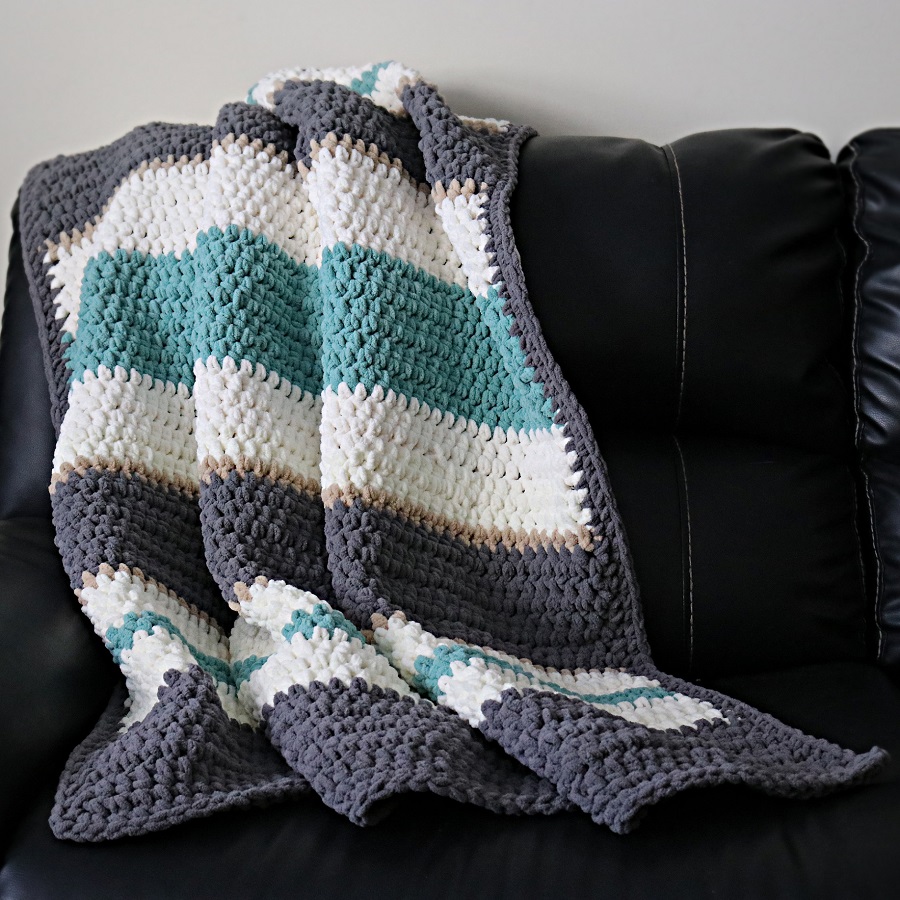 Starting Your Crochet Blanket Project
Starting Your Crochet Blanket Project
Before diving into crocheting a blanket, it’s important to understand the basics of blanket sizes and their uses. This will help you create a functional piece that fits your needs. Here are simple steps to assist beginners in getting their crochet blanket project underway.
Understanding Blanket Sizes and Uses
The size of your crochet blanket depends on how you plan to use it. Smaller blankets, like baby blankets or lapghans, are great for a quick project. Larger ones, such as afghans or throws, are ideal for snuggling on the couch. A typical lap blanket might measure around 35 by 48 inches, while a full afghan could be 50 by 65 inches or more.
Uses for crochet blankets vary widely. They can serve as cozy wraps, stylish sofa throws, or delightful gifts. Knowing the blanket’s purpose will guide your yarn choice, stitch pattern, and size. If you’re crocheting a blanket for a specific season, consider the thickness. Light cotton works for summer, while thick wool suits colder weather.
Creating a Foundation Chain
Every crochet blanket starts with a foundation chain. This is a row of chain stitches that determine the width of your blanket. Begin with a slip knot on your hook and yarn over to create the first chain. Continue making chains until you reach the desired width.
To ensure your chain isn’t too tight or loose, use a crochet hook that matches your yarn weight. A too-tight foundation can make your blanket curl, while a too-loose one can lead to an uneven edge.
Remember to count your chains carefully. The number of starting chains should align with your pattern repeat. Adding or reducing your chain count will change the blanket size, so adjust mindfully.
Once you’ve mastered the foundation chain, you’ll be ready to learn various blanket stitch patterns. With the right materials, stitches, and sizing, you’re now set to begin the rewarding journey of crocheting a blanket.
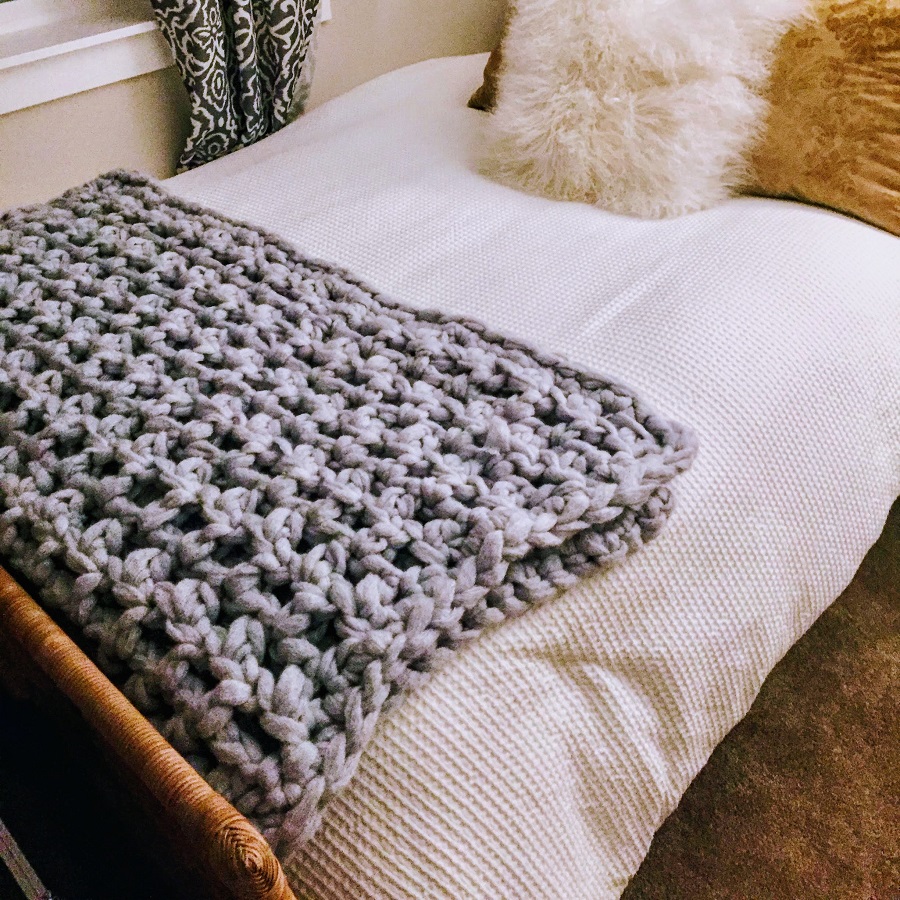 Blanket Stitch Patterns for Beginners
Blanket Stitch Patterns for Beginners
Moss and Chevron Stitches
As you start crocheting a blanket, consider the moss and chevron stitches. The moss stitch, also known as the linen stitch, involves a simple alternating pattern of single crochet and chain stitches. This creates a woven-like, dense fabric that’s great for warmth. To begin, alternate between a single crochet and a chain one, skip a stitch, then do a single crochet in the next stitch, repeating this for each row.
The chevron stitch is a wavy pattern made by creating peaks and valleys with increases and decreases in your stitches. Start by doing a series of double crochets, and to form the peak, do three double crochets in the same stitch. For the valley, skip two stitches and continue with double crochets. The chevron creates a dynamic and textured look for your blanket.
Shell and Granny Stripe Stitches
The shell stitch combines multiple double crochets into the same stitch to create a shell-like design. This pattern gives a lovely, lacy effect that works well for lighter blankets. To make a shell, do five double crochets in the same stitch, skip two stitches, and secure the shell with a single crochet in the next stitch.
Granny stripe stitches are a variation of the classic granny square. They’re worked in groups of three double crochets, with each group separated by a space of one or two chains. This stitch pattern is not only beautiful but also grows quickly, making it rewarding for beginners. The resulting stripes give your blanket a cozy, traditional look.
Classic V-stitch and Granny Squares
The classic V-stitch is a simple, yet elegant pattern that involves creating a ‘V’ by doing a double crochet, chain one, and another double crochet all in the same stitch. Easy to learn, the V-stitch creates a delicate and open fabric that’s perfect for lightweight blankets.
Finally, granny squares are perhaps the most iconic crochet pattern. They are individual squares made up of clusters of double crochets, usually bordered with a contrasting color. Granny squares can be joined to create a blanket of any size. This technique is excellent for using up leftover yarn and allows you to mix and match colors creatively.
These beginner-friendly stitch patterns provide the foundation for endless project possibilities. By mastering them, you can start crocheting a blanket that’s both satisfying to make and delightful to use.
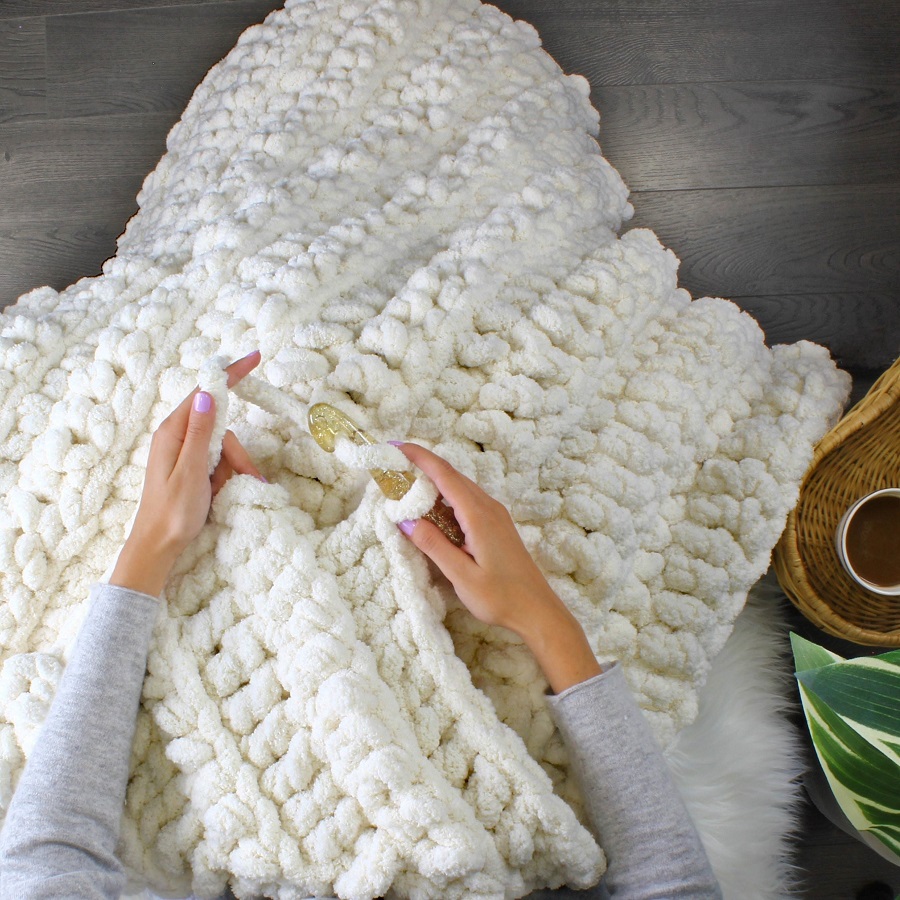 Tips for Crocheting a Colorful Afghan Blanket
Tips for Crocheting a Colorful Afghan Blanket
Crocheting a blanket with various colors adds vibrancy and character to your work. In an Afghan blanket, the weave of colors can turn a simple design into a treasured heirloom. Let’s explore some tips on how to effectively change yarn colors and combine different colors and textures for a personalized touch.
How to Change Yarn Colors
To change colors without knots or tails, follow these steps:
- Work your stitch until the last step.
- Stop before completing the stitch fully.
- With the new color, yarn over and complete the stitch.
- Continue with the new color.
This seamless method avoids knots and creates a clean color transition. Use stitch markers to remind you where to change colors. Practice makes perfect, so try on a small swatch first.
Combining Colors and Textures
Mixing colors and textures can give your blanket depth and appeal. Here are simple strategies:
- Select a color palette that complements each other.
- Choose a main color to anchor the blanket’s design.
- Add a pop of contrast with a bright or dark shade.
- Mix yarn textures, like smooth with fluffy, for interest.
- Follow a repeating pattern or randomize for uniqueness.
Balancing colors and textures will make your crocheting experience enjoyable and produce a beautiful, custom blanket. Remember, your blanket is your canvas – have fun with it!
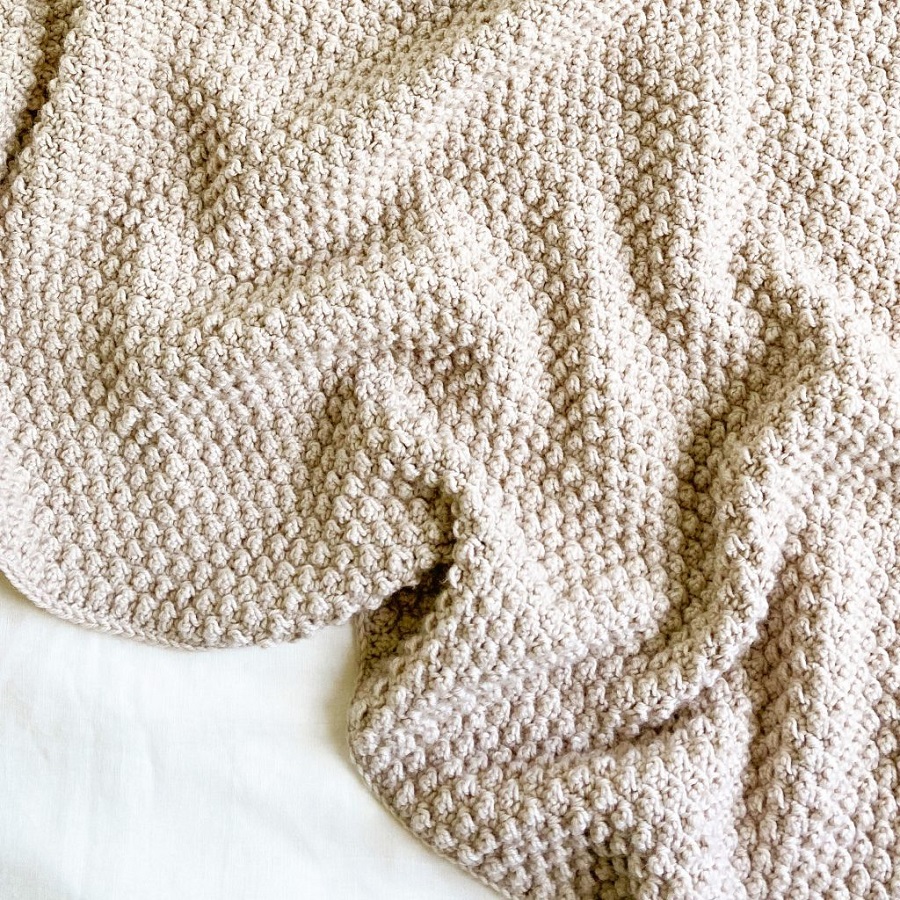 Free Crochet Afghan Blanket Patterns
Free Crochet Afghan Blanket Patterns
Creating a crochet afghan blanket opens up a world of possibilities for beginner crafters. With the right pattern, even those new to crocheting can embark on making a beautiful, functional piece that can be treasured for years. This section provides resources and patterns suited for beginners, as well as options for those looking to advance their skills.
Beginner-Friendly Patterns and Resources
If you’re just starting out, easy patterns will help you gain confidence and skill. Look for patterns with repetitive stitches and minimal color changes. These typically involve basic stitches like the single crochet, double crochet, or granny squares. Resources like online databases, crochet books, and crafting forums are invaluable. Many offer free patterns perfect for beginners. They provide step-by-step instructions, helpful tips, and a sense of community support for new crafters.
Free resources often include video tutorials that visually guide you through each part of the process, from starting your foundation chain to finishing off your blanket. Always look out for patterns that come with detailed instructions, clear photos, and possibly customer support for any inquiries.
Patterns for Different Skill Levels
As your crocheting skills grow, you may want to try more complex projects. Patterns for intermediate or advanced crafters often introduce new stitches, intricate color work, and varied textures. They might involve techniques like cable stitching, lacework, or joining motifs in creative ways. These patterns still include helpful instructions but may assume a little more prior knowledge.
Don’t be afraid to challenge yourself with a harder pattern once you’re comfortable with the basics. Completing a more complex blanket can be extremely rewarding, providing not only a beautiful product but also a sense of personal achievement. There are countless patterns available catering to a wide range of skill levels, so you can find something that matches your abilities and interests.
Remember, crocheting a blanket is a journey – start with simple stitches and, as you grow more confident, embrace more advanced techniques and patterns. Happy stitching!
